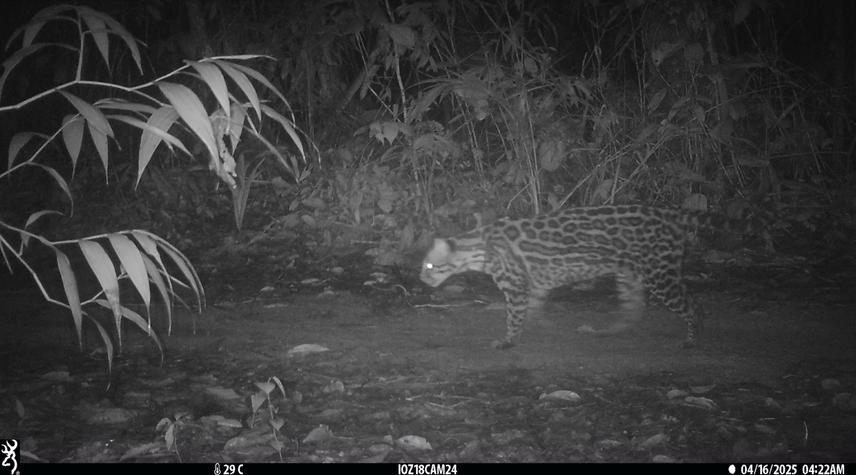Alice Armstrong
Suriname’s lush rainforests are home to six wild cat species: jaguar, puma, ocelot, margay, jaguarundi, and the elusive northern tiger cat. Yet despite this biodiversity, very little is known about how these species are distributed, perceived, or threatened. No baseline ecological data exist for many regions, and no prior study has integrated ecological, cultural, and socio-political factors across all six species in Suriname.

An ocelot caught on a trap cam in Upper Suriname. © Alice Armstrong.
Roaring Resilience is the first project of its kind to holistically assess threats to wild cats in Suriname, with a particular focus on land rights violations and illegal logging by overseas companies operating in Saamaka Tribal territory. These activities, often linked to Chinese and Singaporean firms, continue despite international rulings that affirm Saamaka land rights. Logging roads are frequently used for poaching and wildlife trafficking, raising the risk of multiple environmental crime convergence involving wild cat parts.
This project fills urgent knowledge gaps while promoting inclusive, community-led conservation.
Objective 1: Regional Perceptions and Threat Mapping Across the Guianas
Interviews with conservationists, Indigenous leaders, NGOs, and enforcement officers in Suriname, Guyana, and French Guiana will generate the first cross-border understanding of how all six wild cat species are perceived and threatened. This includes assessing drivers of poaching and trade, species-specific beliefs, and enforcement challenges. These insights will inform regional policy and national action plans.
Objective 2: Land Use, Culture, and Conflict in Saamaka Territory
Through community interviews and ethnographic fieldwork, we will explore how cultural beliefs and land use types such as agriculture, road access, and illegal logging shape human–wild cat interactions. This includes documenting how land access and connectivity influence involvement in the illegal wildlife trade, particularly in communities impacted by extractive foreign companies operating without consent in Saamaka territory.
Objective 3: Measuring Wild Cat Responses to Human Disturbance
We are deploying 80 camera traps across three villages in high-, medium-, and low-disturbance zones to generate the first ecological baseline for wild cats in the region. This will help assess how different felid species respond to agriculture, logging, and cultural context. Findings will support conservation planning, including identifying areas for future corridor protection.
Objective 4: Workshops for Coexistence and Knowledge Exchange
Based on findings from interviews and ecological monitoring, we will deliver participatory workshops in each community. These will explore strategies to reduce conflict such as retaliatory killings, raise awareness about the illegal wildlife trade, and support community-led conservation. Workshops will produce educational materials and culturally relevant conflict mitigation plans.
Objective 5: Ecosystem Health Through Mammal Diversity
Camera trap data will also be used to measure broader mammal diversity as an indicator of ecosystem health. By comparing species richness and average body size across land use types, we can assess how wild cat declines reflect wider ecological degradation.
Ethical Commitments and Community Leadership
All work is guided by Free, Prior, and Informed Consent (FPIC) and has been approved by the UCL High-Risk Ethics Committee and the Surinamese government. Local research assistants will be trained and paid fairly, and community leaders will help shape research priorities. We are working closely with the Limbo Teego Foundation and Vereniging Saamaka Gemeenschappen (VSG) to ensure long-term impact and accountability.
Roaring Resilience is not only uncovering hidden threats to Suriname’s wild cats. It is also strengthening Indigenous leadership, building conservation capacity, and contributing critical data to shape future environmental policy.